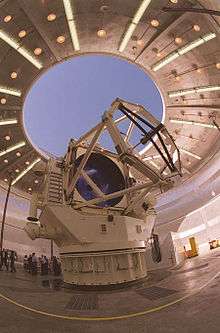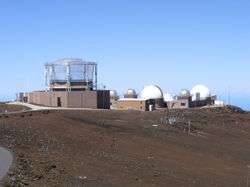Haleakala Observatory
|
Haleakalā Observatory with AEOS Telescope (left) | |||||||||
| Organization | University of Hawai'i | ||||||||
|---|---|---|---|---|---|---|---|---|---|
| Location | Haleakalā, Hawaii, U.S. | ||||||||
| Coordinates | 20°42′30″N 156°15′26″W / 20.7083°N 156.2571°WCoordinates: 20°42′30″N 156°15′26″W / 20.7083°N 156.2571°W | ||||||||
| Altitude | 3,052 meters (10,013 ft) | ||||||||
| Established | 1961 | ||||||||
| Website |
www | ||||||||
| Telescopes | |||||||||
| |||||||||
|
| |||||||||
The Haleakalā Observatory on the island of Maui, also known as the Haleakalā High Altitude Observatory Site, is the location of Hawaii's first astronomical research observatory.[1] It is owned by the Institute for Astronomy of the University of Hawai'i, which operates some of the facilities on the site and leases portions to other organizations. Tenants include the Air Force Research Laboratory (AFRL) and the Las Cumbres Observatory Global Telescope Network (LCOGTN). At over 3,050 meters (10,010 ft) in altitude, the summit of Haleakalā is above one third of the Earth's atmosphere and has excellent astronomical seeing conditions.[2]
Facilities
Mees Solar Observatory
The Mees Solar Observatory (MSO) is named after Kenneth Mees and dedicated in 1964.[1] It consists of one dome with multiple instruments sharing a common mount.[3]
Pan-STARRS
The Panoramic Survey Telescope and Rapid Response System (Pan-STARRS) is a planned array of telescopes plus a computing facility that will survey the sky on a continual basis, and provide accurate astrometry and photometry of detected objects. By detecting any differences from previous observations of the same areas of the sky, it is expected to discover a very large number of new asteroids, comets, variable stars and other celestial objects. Currently, the 1.8 m (71 in) PS1 prototype telescope is in operation and the PS2 is under construction.[4]
Faulkes Telescope North
The Faulkes Telescope North, part of the Faulkes Telescope Project, is a 2.0 m (79 in) reflecting telescope owned and operated by the Las Cumbres Observatory Global Telescope Network. It provides remote access to a research-quality telescope primarily to students in the United Kingdom.[5]
TLRS-4 Laser Ranging System
The TLRS-4 Laser Ranging System is part of the International Laser Ranging Service (ILRS), which provides satellite laser ranging and lunar laser ranging data.[6] The TLRS-4 replaced an older facility in order to provide continuity of data. The old facility now houses telescopes of the Pan-STARRS project.[7]
Zodiacal Light Observatory
The Zodiacal Light Observatory currently consists of two instruments. The Scatter-free Observatory for Limb Active Regions and Coronae (SOLARC or SOLAR-C) telescope is a 0.5 m (20 in) off-axis reflecting coronagraph that is used to study the Sun's corona.[8] The Day-Night Seeing Monitor Telescope System (DNSM) makes telescope-independent observations of perturbations in the atmosphere above Haleakala.[9]
Maui Space Surveillance Complex
The Air Force Office of Scientific Research (AFOSR) of the Air Force Research Laboratory (AFRL) operates the Maui Space Surveillance Complex (MSSC), which is part of the Air Force Maui Optical and Supercomputing Site (AMOS). Located at the MSSC are the 3.67 m (144 in) Advanced Electro Optical System Telescope (AEOS),[10] the Maui Space Surveillance System (MSSS), and the Ground-based Electro-Optical Deep Space Surveillance (GEODSS). The MSSS uses a number of optical assets, including a 1.6 m (63 in) telescope, two 1.2 m (47 in) telescopes on a common mount, a 0.8 m (31 in) beam director/tracker, and a 0.6 m (24 in) laser beam director.[11] The GEODSS uses two 1.0 m (39 in) telescopes and one 0.38 m (15 in) telescope.[12]
Future facilities
- The Advanced Technology Solar Telescope (ATST) is a 4.0 m (160 in) solar telescope currently under construction[13] by the National Solar Observatory.[14]
- The AFRL has plans to build a mirror re-coating facility adjacent to the AEOS building.[12]
Former facilities
- A Baker-Nunn telescope operated from 1957 to 1976 as part of Project Space Track.[15]
- The Lunar Ranging Experiment (LURE) Observatory operated from 1974 until 1994.[15] The Pan-STARRS PS1 now resides in the south dome of the LURE facility and the PS2 is being built in the north dome.
- The University of Chicago Enrico Fermi Institute operated the Haleakala Cosmic Ray Neutron Monitor Station from 1991 to 2007.[15][16]
- The Haleakala Gamma Ray Observatory was a six-mirror Imaging Atmospheric Cherenkov Telescope on an equatorial mount. It began operating in 1981 and was upgraded in 1988.
- The Multicolor Active Galactic Nuclei Monitoring (MAGNUM) was a 2.0 m (79 in) near infrared telescope operated by the University of Tokyo.[17] It was housed in the LURE facility's north dome from 1998 to 2008.[15]
- Observations of airglow were made from a platform near the middle of the site in the 1960s and 1970s. The platform is now used for temporary projects.[12]
- The Near-Earth Asteroid Tracking (NEAT) program operated from 2000 to 2007 using one of the MSSS 1.2 m telescopes.
Non-astronomical facilities
- The Federal Aviation Administration operates a facility immediately to the west of the observatory site.[15]
- The Department of Energy also operates a facility immediately to the west of the observatory site.[15]
- A small building on the site is used by the Haleakalā Amateur Astronomers.[15]
Gallery
| Wikimedia Commons has media related to Haleakala Observatory. |
 Air Force facilities from the west
Air Force facilities from the west AEOS telescope
AEOS telescope
See also
References
- 1 2 "IfA Maui History". University of Hawai‘i Institute for Astronomy. Retrieved 2012-01-09.
- ↑ Bradley, Eliza S.; Roberts, Jr.; Bradford, L. William; Skinner, Mark A.; Nahrstedt, David A.; Waterson, Mark F.; Kuhn, Jeff R. (January 2006). "Characterization of Meteorological and Seeing Conditions at Haleakala". Publications of the Astronomical Society of the Pacific. 118 (839): 172. Bibcode:2006PASP..118..172B. doi:10.1086/497622.
- ↑ "Haleakala Observatories". University of Hawai‘i Institute for Astronomy. Retrieved 2012-01-09.
- ↑ "Project Status - Pan-Starrs - Panoramic Survey Telescope & Rapid Response System". University of Hawai‘i Institute for Astronomy. Retrieved 2012-01-09.
- ↑ "About Us | Faulkes Telescope Project". Faulkes Telescope Project. Retrieved 2012-01-09.
- ↑ "About ILRS". International Laser Ranging Service. Retrieved 2012-01-09.
- ↑ "TLRS-4 Laser Ranging System". University of Hawai‘i Institute for Astronomy. Retrieved 2012-01-09.
- ↑ "Institute for Astronomy Solar-C". University of Hawai‘i Institute for Astronomy. Retrieved 2012-01-09.
- ↑ "Day - Night Seeing Monitor DNSM Telescope System". University of Hawai‘i Institute for Astronomy. Retrieved 2012-01-09.
- ↑ "Fact Sheets: AFOSR: AEOS at AMOS". Air Force Research Laboratory. Retrieved 2012-01-09.
- ↑ "Air Force Maui Optical and Supercomputing Site". Air Force Research Laboratory. Archived from the original on 2005-08-28. Retrieved 2012-01-09.
- 1 2 3 "Haleakalä High Altitude Observatory Site Long Range Development Plan" (PDF). University of Hawai‘i Institute for Astronomy. January 2005. Retrieved 2012-01-09.
- ↑ Joseph McMullin; Thomas Rimmele (2012-11-14). "NSO Announces Start of ATST Site Construction" (Press release). National Solar Observatory.
- ↑ "Frequently Asked Questions | ATST". National Solar Observatory. Retrieved 2012-01-09.
- 1 2 3 4 5 6 7 "Haleakalā High Altitude Observatory Site Management Plan" (PDF). University of Hawai‘i Institute for Astronomy. 2010-06-08. Retrieved 2012-01-09.
- ↑ Pyle, K. R. (1993). The Haleakala Cosmic Ray Neutron Monitor Station: Intercalibration with the Huancayo Station. 23rd International Cosmic Ray Conference. 3. p. 609. Bibcode:1993ICRC....3..609P.
- ↑ Yoshii, Y.; Kobayashi, Y.; Minezaki, T. (May 2003). "The MAGNUM (Multicolor Active Galactic NUclei Monitoring) Project". Bulletin of the American Astronomical Society. 35: 752. Bibcode:2003AAS...202.3803Y.
External links
- University of Hawaii Institute for Astronomy - Haleakala Observatory
- "Maui's Night Sky" Time elapse photography of night sky from Haleakala by Wally Pacholka. Maui No Ka 'Oi Magazine Vol.14, No.3 (May 2010)
